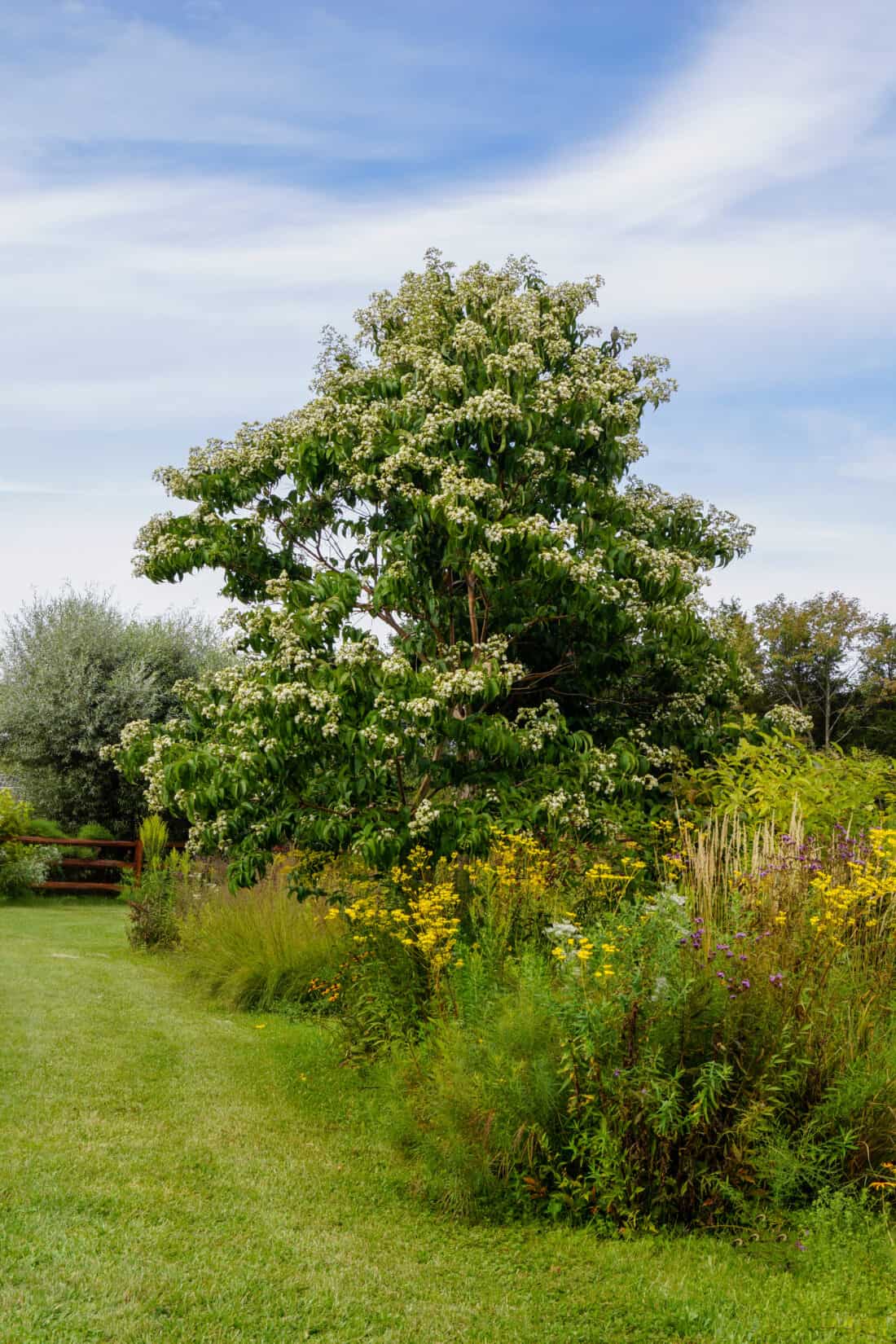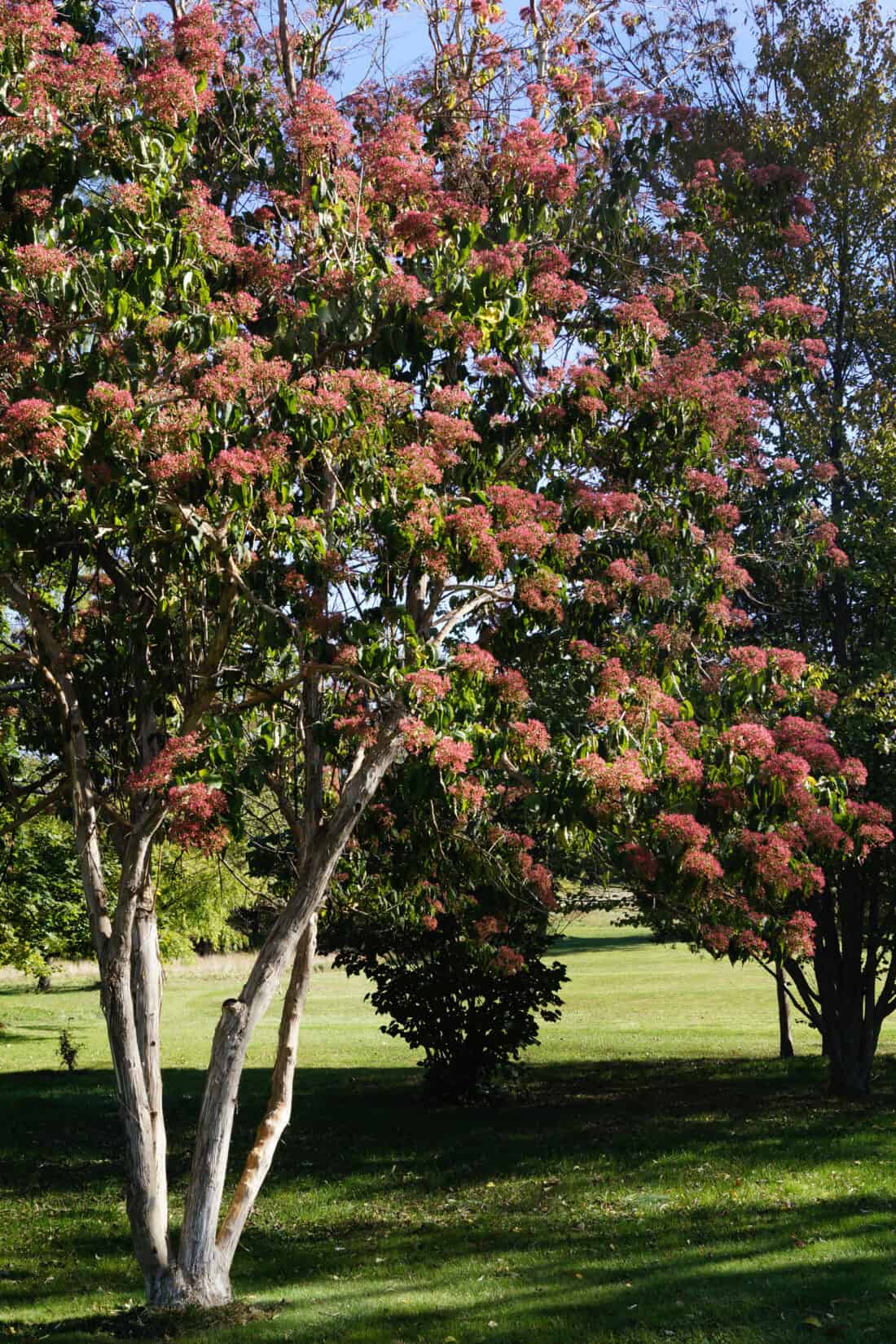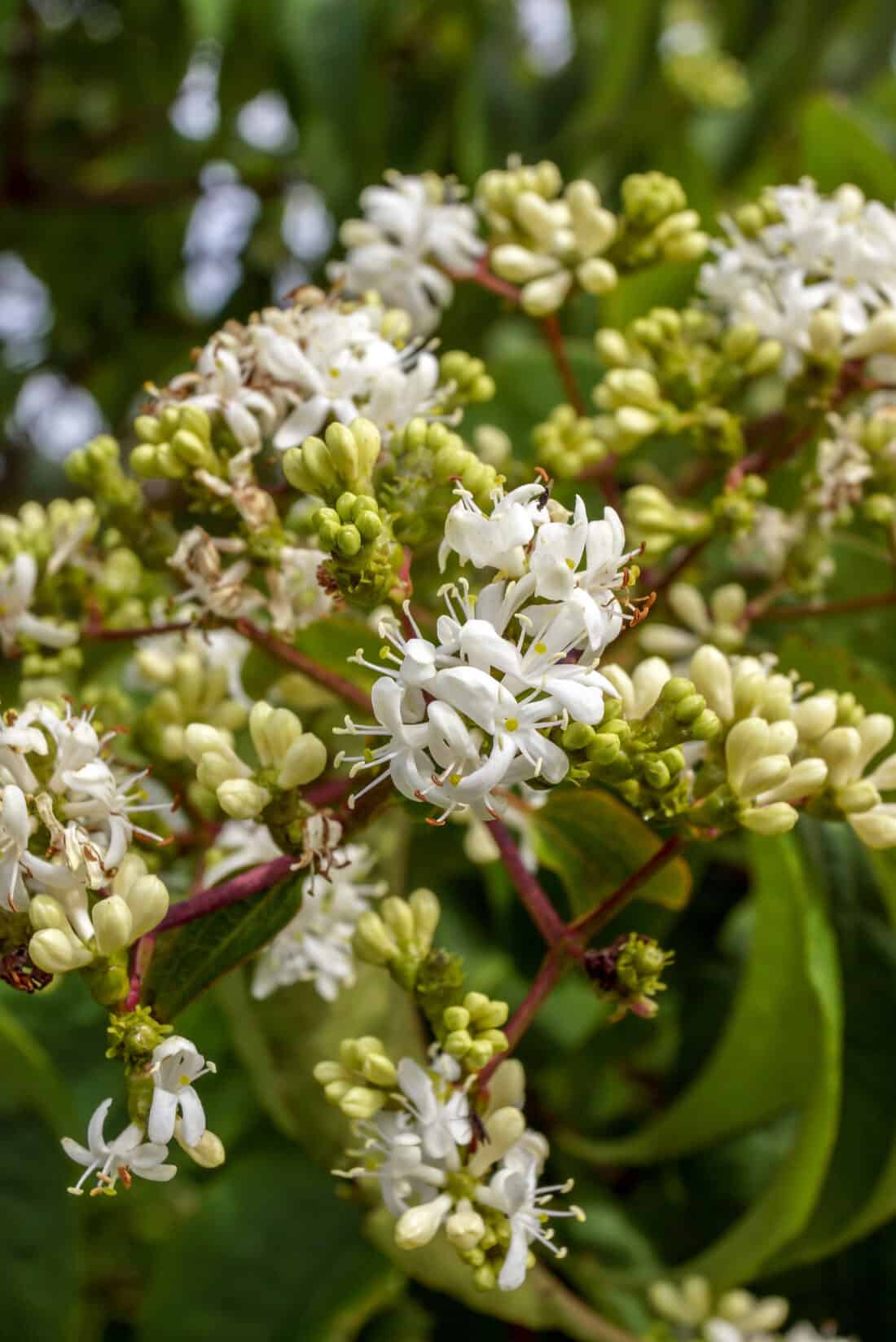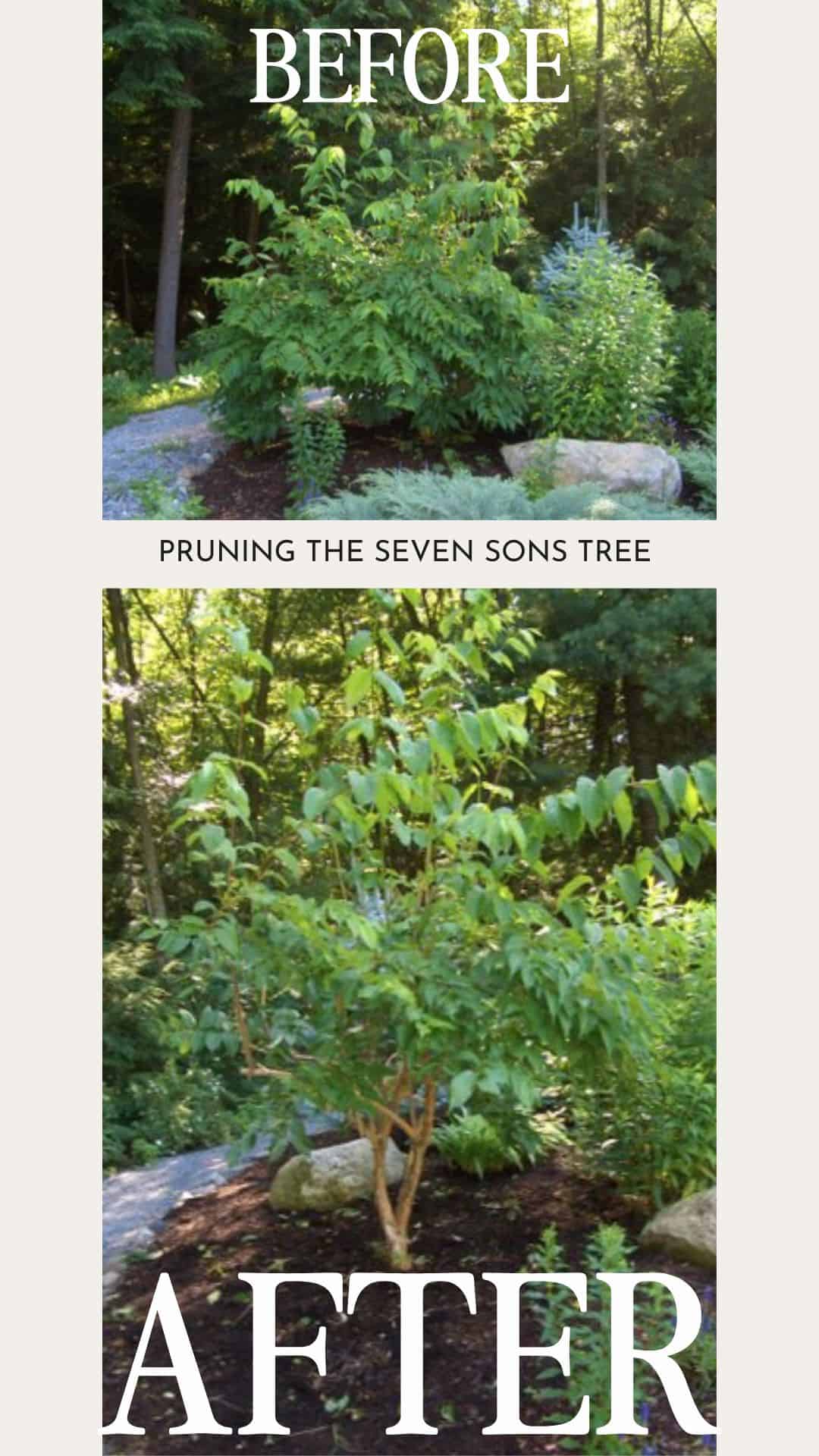I looked up yesterday and was surprised to realize my Heptacodium miconioides (Seven Sons Tree) was in full bloom. Even though it is mid-september, it somehow seems early – but maybe not. The seven sons tree is an anomaly in my garden; in full bloom just when everything else is looking a bit tired and providing sweet smelling flowers in the garden right through the fall.
I adore this tree primarily because it blooms at exactly the time that it seems like it shouldn’t. The flower heads are a cluster of jasmine-like white blooms and feel like they belong in late spring. I have the sense the crabapple and dogwood should also be blooming. But actually the apple trees are ready to be picked.
A fall blooming tree feels off-kilter and rebellious. (in the best way)
If you have room, heptacodium miconoides is a fantastic addition to any garden.
And the bees LOVE this tree too. It is currently swarming with pollinators.

This is my guide to adding Heptacodium Miconoides – Also known as The Seven sons tree to your garden.
A Closer Look at the Seven Sons Tree: Unveiling Its Allure
This unique tree, scientifically known as Heptacodium miconioides, is native to China. It was first introduced in the United States in the late 1980s, captivating garden enthusiasts and landscape designers alike.
What sets this tree apart are its distinct features. First, its bark, which gracefully peels away to reveal layers of color, adds year-round visual interest. It has a shaggy look and adds lots of texture to a planting design. Second, the fragrant flowers, which bloom in late summer or early fall (mine typically blooms mid-September in New England), attracting pollinators and perfuming your garden with a sweet honeysuckle-like aroma.
Seven sons tree’s white flower clusters are beautiful and thick – when this tree blooms, it isn’t just a blossom here and there, it is more like a full eruption that engulfs the crown.
After the petals of the flowers fall away, the tree takes on pinkish tones with clusters of the remaining rosy pink calyces.

The flowers are seven-lobed (which gives part of the latin name – hepta – for seven) clusters of delicate, star-shaped blossoms adorning its branches.
Heptacodium miconioides – pollinator magnet
Heptacodium miconioides is a magnet for pollinators, drawing in bees and butterflies with its nectar-rich blooms. There are days that I walk by this tree in the fall and it is actually buzzing (loudly) with activity. It is the hands-down obvious homecoming queen of my garden’s annual pollinator popularity contest.
What’s truly fascinating is its late-season showtime. I know it’s going to bloom in the fall, but it never the less seems to surprise me every year. Just when other trees are winding down, this beauty takes the stage, bursting into a profusion of fragrant flowers in late summer and early fall.
I often wonder if it is such a popular tree with pollinators primarily because it offers a lifeline to pollinators when they need it most.
Just like spring bulbs can be harbingers of a new season, this tree marks the shift from long hot days to shorter crisper ones.

Design Ideas and Garden Applications
Seven son tree is a graceful, midsized, and arch topped tree. It adds sculptural beauty that can be appreciated and highlighted by the surrounding architecture (or lack of), or plants.
In my own garden, it anchors a large bed and has planting all around it. I grow quince, viburnum, rose of sharon, angelica gigas, hosta, heuchera, solomons seal and actea around the base.
I originally loved the idea of planting adjacent grasses to compliment and contrast with the bark – but in an earlier iteration of this bed, I chose incompatible grass varieties. Seven son tree can take a little bit of shade but don’t forget that it is a tree – so it makes shade. Grasses often are happier with full sun and don’t look their best if left to get floppy without enough light. If you can make sure the tree-grass combo provides the right light for both elements then this would be a beautiful choice (I just couldn’t make that work in my spot).
Companion plants for Heptacodium miconioides – Part to full- sun
Other thoughts on companion planting to pair with Heptacodium miconioides, the seven sons tree:
1. Spring Bulbs: Plant early spring bulbs like tulips and crocuses around the base of the tree. Their vibrant colors will create a striking contrast against the tree’s peeling bark. I have daffodils around mine their dying foliage gets hidden amongst the other planting that emerges later.
2. Ferns: Ferns, with their graceful fronds, make excellent companions. Their feathery textures create an elegant contrast to the tree’s structure, and they thrive in the shade provided by the tree’s canopy.
3. Sedum: Sedum varieties, like ‘Autumn Joy,’ offer late-season color and thrive in well-drained soil. Their clusters of star-shaped flowers harmonize with the tree’s late-season bloom. I have sedum all over my yard – it is a great companion to so many things and can really tie together your over all design.
4. Japanese Forest Grass (Hakonechloa): This ornamental grass adds a touch of elegance with its cascading, golden-green foliage. It provides a beautiful textural contrast to the seven sons tree.
5. Native Wildflowers: Incorporate native wildflowers like coneflowers, black-eyed Susans, and milkweed to support local wildlife and create a vibrant, naturalistic garden.
6. Hostas: Hostas thrive in partial shade and offer a wide variety of leaf shapes and colors, adding interest to the lower levels of your garden beneath the tree.
7. Hydrangeas: Bigleaf hydrangeas (Hydrangea macrophylla) with their large, showy blooms make a stunning companion, especially if you have slightly acidic soil.
Remember to consider the specific growing conditions in your garden, such as sunlight, soil type, and climate, when selecting companion plants. Mixing and matching these plants can create a dynamic and ever-changing landscape around your seven sons tree.
Companion plants for Seven Son Tree in a spot with lots of Sunlight
1. Lavender: The fragrant and pollinator-friendly blooms of lavender pair beautifully with the late-season flowers of the seven sons tree. Plus, the silvery foliage of lavender complements the tree’s bark. (but make sure this is a sun match – the lavender wants full sun.
2. Bee Balm: Bee balm, or Monarda, not only attracts pollinators but also adds a burst of color with its vibrant red, pink, or purple blooms. It creates a lively and dynamic garden scene and tends to make your garden feel a bit more wild with its habit of filling in all the empty spots with blooms.
3. Native Wildflowers: Incorporate native wildflowers like coneflowers, black-eyed Susans, and milkweed to support local wildlife and create a vibrant, naturalistic garden.
Heptacodium miconioides – Seven Sons Tree Care Tips
The Seven Sons tree (hetacodium miconiodes) grow pretty fast and when new and small they look kinda like floppy bushes. (below) But a simple prune can near instantly turn it into an graceful upright tree.

That is some satisfying pruning when you can make a blob into a winsome elegant little tree.
In my garden, I’d consider he small tree or maybe even a large shrub. It will top out at less than 25 feet. I find it to be a little bit of a sloppy grower – requiring regular pruning. This can be done all year round but is best in early spring. It doesn’t sucker, but does have a tendancy to get lots of crossing branches and internal branches that can make the tree have a less than elegant appearance with out regular care. A hard prune does not phase this tree. The blooms can make the branches begin to hang low so I tend to limb it up from the bottom to highlight the multi-stem appearance and reduce weight.
Seven Sons Tree Problems
Seven Sons trees may face issues like pests, diseases, and environmental stress. Common problems include leaf spot diseases, aphid infestations, and root rot (though I’ve never had any of these issues in my own garden). The thing I do find annoying is that this tree needs above-average attention to pruning. It tends to throw out some wonky branches and lots of crossing branches. It does not have a naturally elegant habit – but with the regular removal of branches, it stays nice.
More posts you might be interested in:
images: GardenWeb., Nancy J. Ondra
My Heptacodium flowered but then the brackets dried up and n did not turn pink. Is it dying?
Hi mary -It is hard for me to say, but I wouldn’t assume that it is dying unless you have other reasons to think this might be the case. Drought, insect pressure and weather can impact trees and plants. Trees are resilient – wait see what happens next year.